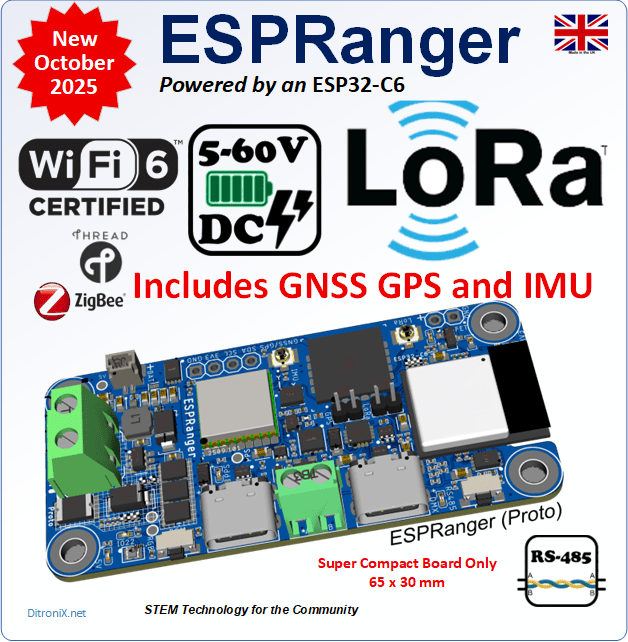Description
ESPRanger is a compact and powerful STEM Community board which is designed for LoRa (Long Range wireless communication), with GNSS (Global Navigation Satellite System) and IMU (Accelerometer and Gyroscope). Essentially a great compact Swiss-army-knife LoRa GPS Tracker and IMU project.
Note: The ESPRanger will be on backorder during the KickStarter campaign. All orders taken expect to be shipped during November.
ESPRanger – LoRa – DMX Lighting Controller
Top Level Devices
The purpose of ESPRanger, is to provide a very compact board which includes the below main features:
- Espressif ESP32-C6
- WiFi, Bluetooth, Zigbee and Thread
- EByte E22-900MM22S
- LoRa SX1262 module for 868MHz through to 915MHz
- ATGM336H-5N
- High performance multi-constellation GNSS receiver for GPS, Galileo, QZSS and BDS
- ST LSM6DSL
- IMU with 3D Digital Accelerometer and 3D Digital Gyroscope
- Chipanalog CS48520D
- Industry Standard RS-485 interface
- TI TMP102 -Digital Temperature
- Siproin SSP9481 -5 to 60V DC SMPS for wide ranging power input, providing a stable 5V
- OnSemi NCP167BMX330 -5V to 3V3 DC SMPS
- EEPROM P24C64C -64Kbit storage -Two of these are included, one for ATGM336H and one for the ESP32-C6.
Where can ESPRanger be used?
The ESPRanger board can be used in a wide range of projects and installations such as:
- Agriculture
- Automation
- Commercial
- Drones
- Emergency Response
- Factories
- Farms
- FPV Radio Controlled Vehicles
- Greenhouses
- Homes
- Industry
- LoRa GPS Tracker
- Makers
- Mapping
- Modelling
- Off Grid Systems
- Robotics
- Scientific Research
- Security
- Shipping
- Smart systems
- Solar Farms
- STEM Education
- Surveillance
- Surveying
- Tracking
- Wind Farms
Features (Preliminary)
Radio and U.FL
ESPRanger main MCU is the ESP32-C6 which includes a powerful radio module, opening up a range of IoT applications that include:
Wi-Fi 6
- 2.4 GHz (2400 ~ 2483.5 MHz)
- 802.11ax (20 MHz bandwidth)
- 802.11b/g/n (20/40 MHz bandwidth)
- CE Max EIRP 19.81 dBm
Bluetooth
- 2.4 GHz (2400 ~ 2483.5 MHz)
- Bluetooth LE
- Bluetooth 5.3
- Bluetooth Mesh
- CE Max EIRP 18.46 dBm
Thread 1.4
- 2.4 GHz (2405 ~ 2480 MHz)
- 802.15.4
- Thread Mesh
- CE Max EIRP 10.29 dBm
Zigbee 3.0
- 2.4 GHz (2405 ~ 2480 MHz)
- 802.15.4
- Zigbee Mesh
- CE Max EIRP 10.40 dBm
Zigbee and mesh are expanding in an range of home, farming and industrial applications, so will be interested to see how this develops over time.
Using a mix of Ethernet and Zigbee, installations could offer remote mesh systems, with a mix of communications technologies.
LoRa and LoRaWAN
The main focus of the ESPRanger board was sensor flexibility and the ability to send this data to the outside world. LoRa provides a Long Range wireless communication technology.
The ESPRanger includes an EByte E22-900MM22S LoRa module, with Semtech SX1262. This module covers 850 to 930MHz, so allowing the ESPRanger to work in many countries around the World.
Example bands:
- AS923 (AS1) band (920-923 MHz) in Japan, Malaysia, Singapore
- AS923 (AS2) band (915–928 MHz) in Asia
- AU915 band (915–928 MHz) in South America
- CN779 band (779-787 MHz) in China
- EU868 band (863–870 MHz) in Europe
- IN865 band (865-867 MHz) in India
- KR920 band (920-923 MHz) in Korea
- RU864 band (864-870 MHz) in Russia
- US915 band (902–928 MHz) in North America
LoRa networks supported include TTN, Helium, Meshtastic and ChirpStack.
An U.FL antenna connector is provided to allow internal or external antennas to be fitted.
GNSS
The ATGM336H-5NR32 is a high-performance, low-power, multi-constellation GNSS module, which features 32 tracking channels to fully support positioning and navigation. The ESPRanger supports:
- American GPS
- EU Galileo
- Chinese BDS (Beidou)
- Japanese QZSS
- Satellite enhanced system SBAS (WAAS,EGNOS,GAGAN, MSAS)
A dedicated EEPROM has been included to allow the module to to store the almanac, which is a inventory of currently available satellites and their orbits.
An external optional plug-in CR2302 3V coin battery maybe added.
An U.FL antenna connector is provided to allow internal or external antennas to be fitted.
IMU
A requested feature by some users is an on-board Digital Accelerometer and Gyroscope. The LSM6DSLTR has been included on the ESPRanger board.
This IMU is an always-on compact 3D device and offers low power but with excellent and extensive features.
RS-485
To interfacing to other devices such as Smart Meters, Devices and Smart Batteries which have an RS-485 MODBUS interface, the ESPRanger includes a standard industry interface which allows you to collect, or control, other devices on the RS-485 bus.
This RS-485 interface could also be used to control local CCTV on remote installations, or even send data from the ESPRanger board over a single twisted pair, up to around 1,200 meters (4,000 feet), in distance. Ideal for farms and remote installations.
DMX
The RS-485 interface can also be used for DMX control, such as Lighting and Audio systems.
Ship Kit
- ESPRanger SDK Board
- 4-Pin Header Female (for OLED)
- 2mm Jumpers

Reviews
There are no reviews yet.